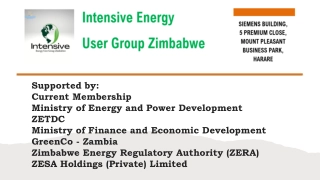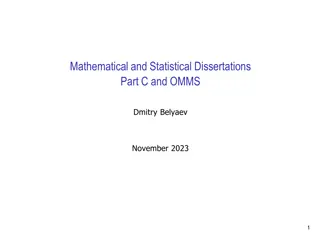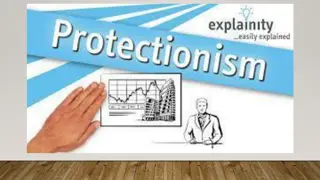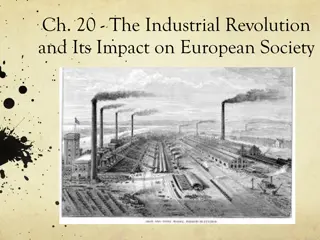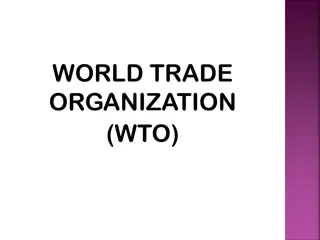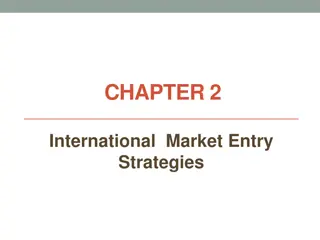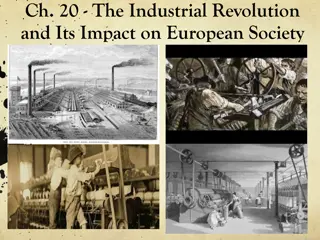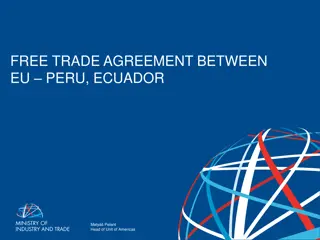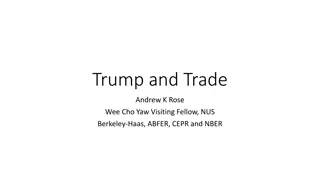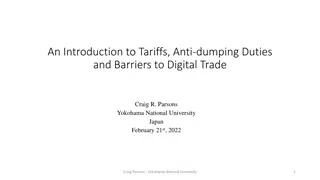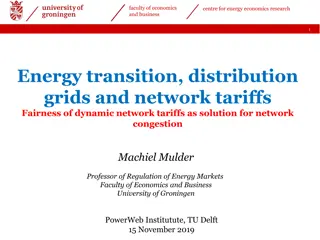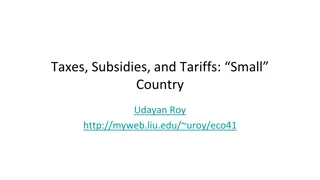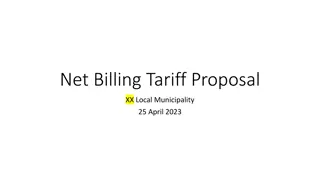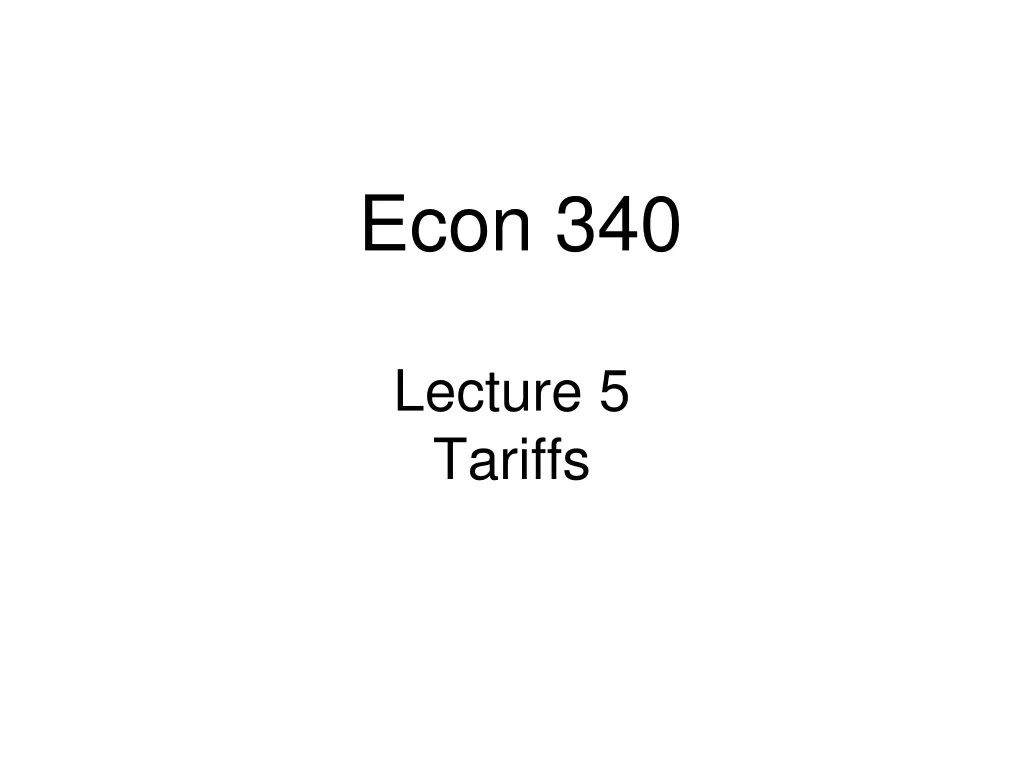
Understanding the Impact of Tariffs on International Trade Dynamics
Explore the concept of tariffs, their implementation, and effects on small and large countries' economies. Learn about the use of tariffs globally, including specific examples like US tariffs on different products and their implications for developing countries. Delve into the complexities of trade policies and their consequences on economic welfare.
Download Presentation

Please find below an Image/Link to download the presentation.
The content on the website is provided AS IS for your information and personal use only. It may not be sold, licensed, or shared on other websites without obtaining consent from the author. If you encounter any issues during the download, it is possible that the publisher has removed the file from their server.
You are allowed to download the files provided on this website for personal or commercial use, subject to the condition that they are used lawfully. All files are the property of their respective owners.
The content on the website is provided AS IS for your information and personal use only. It may not be sold, licensed, or shared on other websites without obtaining consent from the author.
E N D
Presentation Transcript
Econ 340 Lecture 5 Tariffs
Outline: Tariffs What Are They? Who Uses Them? Effects of Tariffs Small Country Case Effects on quantities and prices Effects on economic welfare Large Country Case Effect on world price Effect on welfare Size of These Effects Addenda on Tariffs Lecture 5: Tariffs 2
What Are Tariffs? Tariffs are Taxes on imports Two main types Ad valorem: % of value Specific: $ per unit How are they implemented? At the border, by customs officers They determine What good it is What price to use for ad valorem tariffs Customs officers have power that may be abused (e.g., bribery) Lecture 5: Tariffs 3
Outline: Tariffs What Are They? Who Uses Them? Effects of Tariffs Small Country Case Effects on quantities and prices Effects on economic welfare Large Country Case Effect on world price Effect on welfare Size of These Effects Addenda on Tariffs Lecture 5: Tariffs 4
Who Uses Tariffs? Virtually all countries How big are tariffs? In US, today, average only 2-3% (before Trump) In developing countries, often around 20% Both used to be much higher Some particular tariffs are still much higher And President Trump has put tariffs of 25% on steel 10% on aluminum Up to 25% so far on well over $250 billion of Chinese exports, with more coming on most of the rest Lecture 5: Tariffs 5
Who Uses Tariffs? Sample US tariffs Cars: 2.5% Trucks: 25% Men s cotton shirts Women s blouses Blankets Pullover apparel Tariffs facing exports of developing countries: Nepal 13.2% Bangladesh 13.6% 19.7% 26.9% 8.5% 14.9% Sorry. Men write the tariffs Lecture 5: Tariffs 6
Who Uses Tariffs? Aside: Schavey, The Catch-22 of U.S. Trade US tariffs are much larger against developing countries than against developed countries Who gains and loses? Some US workers gain, but they have social policies to protect them (unemployment insurance, etc.) Developing-country workers lose, and their governments are too poor to help WTO Agreement on Textiles and Clothing (1995) promised to eliminate quotas on these products by 2005, but not tariffs. (It did.) Why Catch-22 ? Countries can only develop by exporting But if they do, we raise tariffs! Lecture 5: Tariffs 7
Outline: Tariffs What Are They? Who Uses Them? Effects of Tariffs Small Country Case Effects on quantities and prices Effects on economic welfare Large Country Case Effect on world price Effect on welfare Size of These Effects Addenda on Tariffs Lecture 5: Tariffs 8
Effects of Tariffs Easy to see from supply and demand Consider a good whose price would be above the world price without trade We will look at two cases: Small country: Too small for its behavior to matter for the world price Large country: Large enough (in market for this good) that its behavior may change world price Lecture 5: Tariffs 9
Effects of Tariffs: Small Country P S Autarky price = Pa Free trade price = world price = PW D Q QS0 QD0 Lecture 5: Tariffs 10
Effects of Tariffs: Small Country P S Effect on Price Pa PW+t PW D Q QS0 QD0 Lecture 5: Tariffs 11
Effects of Tariffs: Small Country P S Effects on Quantities Pa PW+t PW D Q QS0QS1 QD1QD0 Lecture 5: Tariffs 12
Effects of Tariffs: Small Country Why the price increase? On imports Tariff is simply added to the price paid to foreign exporters On domestically produced goods Buyers don t pay the tariff But if price stayed below PW+t, demand for the domestically produced good would be greater than supply This shortage would drive up price Lecture 5: Tariffs 13
Effects of Tariffs: Small Country Thus: what happens due to a tariff: Domestic price rises (by full amount of tariff) Domestic output rises (Employment also rises in this industry) Domestic demand falls Imports (=D S) fall Suppliers gain Demanders lose Gov t gets tariff revenue World sells less to us (but it doesn t lose, because we re too small for it to notice) P S D Q Lecture 5: Tariffs 14
Effects of Tariffs: Small Country How much do we gain and lose? Use changes in consumer surplus and producer surplus from Econ 101 Lecture 5: Tariffs 15
Reminder: Change in Consumer Surplus When price changes, Consumers Gain from price decrease Lose from price increase By amount equal to area to the left of the demand curve while Gain from price decrease, or loss from price increase P D Q Lecture 5: Tariffs 16
Reminder: Change in Producer Surplus Producers Gain from price increase Lose from price decrease By amount equal to area to the left of the supply curve P S Gain from price increase, or loss from price decrease Q Lecture 5: Tariffs 17
Effects of Tariffs: Small Country Apply these to the effects we found for a tariff Also note that the government (and thus the taxpayer) of the country gets benefit of tariff revenue Lecture 5: Tariffs 18
Effects of Tariffs: Small Country P S Effects on Welfare Suppliers gain +a Pa PW+t a c b d PW D Q QS0QS1 QD1QD0 Lecture 5: Tariffs 19
Effects of Tariffs: Small Country P S Effects on Welfare Demanders lose (a+b+c+d) Pa PW+t a c b d PW D Q QS0QS1 QD1QD0 Lecture 5: Tariffs 20
Effects of Tariffs: Small Country P S Effects on Welfare Government gains +c Pa PW+t a c b d PW D Q QS0QS1 QD1QD0 Lecture 5: Tariffs 21
Effects of Tariffs: Small Country P S Effects on Welfare Net for country (b+d) Pa PW+t Country loses from tariff a c b d PW D Q QS0QS1 QD1QD0 Lecture 5: Tariffs 22
Effects of Tariffs: Small Country Summary: Suppliers gain Demanders lose Government gains Net effect on country +a (a+b+c+d) +c Loss = (b+d) P S Pa PW+t c a d b PW D Q QS0QS1 QD1QD0 Lecture 5: Tariffs 23
Effects of Tariffs: Small Country Dead Weight Loss Why? Because demanders and suppliers both are misled by the tariff to behave as if the good s value were PW+t, when in fact the country can buy or sell it for PW. P S PW+t PW D Q Lecture 5: Tariffs 24
Clicker Question Suppose the world price of a good is initially $10 and it then rises to $20. In which of the following cases will the domestic price of the good rise the most? a) It has a $2 specific tariff b) It has a 20% ad valorem tariff c) It has a $4 specific tariff d) It has a 30% ad valorem tariff Price rises from $12 to $22, by $10 $12 to $24, by $12 $14 to $24, by $10 $13 to $26, by $13
Clicker Question Which of the following would cause the dead-weight loss due to a tariff to be zero? a) Domestic supply curve is vertical b) Domestic demand curve is vertical c) Both domestic supply and demand are vertical d) Nothing: dead-weight loss due to a tariff can never be zero
Clicker Question In the graph, initial price is PW and quantities are S0 and D0. A tariff t is then applied to imports. For which demand curve is the dead-weight loss the largest? a) DA b) DB c) DC P S PW+t PW DC DB DA Q D0 S0
Clicker Question Same graph. For which demand curve is the loss to consumers the largest? a) DA b) DB c) DC P S PW+t PW DC DB DA Q D0 S0
Clicker Question Same graph How is this possible? If the country loses more with DA (dead-weight loss) but consumers lose less, who loses more? a) Suppliers b) Government c) Foreigners d) Other industries P S PW+t Gains less, actually PW DC DB DA Q D0 S0
Outline: Tariffs What Are They? Who Uses Them? Effects of Tariffs Small Country Case Effects on quantities and prices Effects on economic welfare Large Country Case Effect on world price Effect on welfare Size of These Effects Addenda on Tariffs Lecture 5: Tariffs 30
Effects of Tariffs: Large Country If the country is not small, but large, then when it reduces its imports of the good from the world market the world price will fall. World Market PW SW Why? Because, with less import demand by large country, world demand shifts left. PW0 PW1 DW0 DW1 QW Lecture 5: Tariffs 31
Effects of Tariffs: Large Country Results due to tariff and fall in world price: Domestic price rises, but by less than the tariff Thus, compared to the same tariff in a small country Output (and employment) rises by less Thus the benefit to suppliers is smaller Demand falls by less Thus the harm to demanders is smaller Imports fall by less Tariff revenue is larger (since imports fall less) Lecture 5: Tariffs 32
Effects of Tariffs: Large Country P S PW0+t PW1+t PW0 PW1 D Q QS0QS1 QD1QD0 Lecture 5: Tariffs 33
Effects of Tariffs: Large Country P S Effects of tariff on Welfare Suppliers gain +a PW0+t PW1+t c e a b d PW0 PW1 D Q QS0QS1 QD1QD0 Lecture 5: Tariffs 34
Effects of Tariffs: Large Country P S Effects of tariff on Welfare Demanders lose (a +b +c +d ) PW0+t PW1+t c e a b d PW0 PW1 D Q QS0QS1 QD1QD0 Lecture 5: Tariffs 35
Effects of Tariffs: Large Country P S Effects of tariff on Welfare Government gains +(c +e ) PW0+t PW1+t c e a b d PW0 PW1 D Q QS0QS1 QD1QD0 Lecture 5: Tariffs 36
Effects of Tariffs: Large Country P S Effects of tariff on Welfare Net for country +e (b +d ) PW0+t PW1+t Country gains from tariff if e >(b +d ) c e a b d PW0 PW1 D Q QS0QS1 QD1QD0 Lecture 5: Tariffs 37
Effects of Tariffs: Large Country Summary: Suppliers gain Demanders lose Government gains Net effect on country Gain or Loss = +a (a +b +c +d ) +(c +e ) +e (b +d ) P S c e a b d D Q Lecture 5: Tariffs 38
Effects of Tariffs: Large Country This possibility of gain from a tariff goes under several names: The terms of trade effect of a tariff The monopoly effect of a tariff The optimal tariff Lecture 5: Tariffs 39
Effects of Tariffs: Large Country exports P The Terms of Trade Effect Definition: A country s Terms of Trade is defined as the price of its exports relative to its imports TOT = imports P If TOTrises, the terms of trade improves because the country gets more imports in return for its exports A tariff by a large country drives down the world price of its imports and thus improves its terms of trade Lecture 5: Tariffs 40
Effects of Tariffs: Large Country The monopoly effect From Econ 101, a monopoly firm increases its profit by Selling less to the market, and hence Raising the price that it gets A large country can increase its welfare by Buying less from the market (via a tariff), and hence Lowering the price that it pays Note: Large country could also gain by restricting exports, as OPEC has done with oil (Not in recent years, but it keeps trying) Lecture 5: Tariffs 41
Effects of Tariffs: Large Country Example of a too large tariff: The optimal tariff If a large country uses a tariff that is too large, it must lose. Thus there is some level of tariff that is optimal P S t D Q Lecture 5: Tariffs 42
Effects of Tariffs: Large Country The optimal tariff Net Welfare Tariff Optimal Tariff Autarky Lecture 5: Tariffs 43
Is the US Large One would think so But evidence from Trump s tariffs in 2018 (see Foy) found US prices rose by full amount of tariffs No fall in prices for foreign exporters Apparently, Even though US appears to be large Our share of the world market is not that big Lecture 5: Tariffs 44
Clicker Question Who loses within a large country when it uses an optimal tariff? a) Domestic suppliers b) Domestic demanders c) The government d) Nobody: only foreigners lose
Outline: Tariffs What Are They? Who Uses Them? Effects of Tariffs Small Country Case Effects on quantities and prices Effects on economic welfare Large Country Case Effect on world price Effect on welfare Size of These Effects Addenda on Tariffs Lecture 5: Tariffs 46
The Size of These Effects See Feenstra Uses analysis like this one to measure effects of protection Sectors with high US protection in 1985: Automobiles Dairy Steel Sugar Textiles and Apparel (All these had quotas and other NTBs as well as tariffs.) Lecture 5: Tariffs 47
The Size of These Effects See Feenstra For 1985, U.S. average tariffs caused dead- weight loss (DWL) for U.S. of DWL = $1.2-3.4 billion per year Sounds like a lot! But U.S. 1985 GDP was $4,181 b. So DWL = 0.03% of GDP TINY! Lecture 5: Tariffs 48
The Size of These Effects Why is the loss from tariffs so small? Most U.S. tariffs are small But note, this is only the DWL The transfer from consumers, to producers and to government, is much larger P S PW+t PW D Q Lecture 5: Tariffs 49
The Size of These Effects Why so small? DWL grows with the square of the tariff Example: Doubling the tariff Multiplies DWL by 4 So DWL due to small tariff is smaller than the tariff itself might suggest P S PW+2t PW+t PW D Q Lecture 5: Tariffs 50



